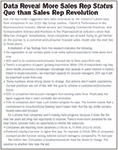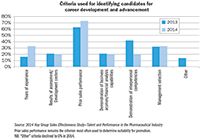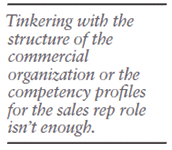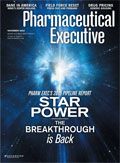Sales Reps and the New Commercial Organization
By rethinking the role of the sales rep and the new skills it demands, pharma companies can put themselves in a prime competitive position.
Structural transformations in the life sciences industry have put the traditional sales role under increasing scrutiny, with the most prominent change being a drastic reduction in field force deployments in the US and Europe. This, argues Hay Group's Ian Wilcox, is where opportunity lies. By rethinking the role of the sales rep and the new skills it demands—and then executing boldly around a new customer-driven master plan—pharma companies can put themselves in a prime competitive position.
Among all the changes that the commercial side of the pharmaceutical industry has undergone in the last decade, the most impactful has been the redistribution of customer influence. There's been a shift away from individual physicians and towards payers (as well as medical institutions and patients). The result of this change? The roles of the sales rep and the commercial organization behind it need to change—and not just incrementally.

(PHOTO: THINKSTOCK)
Today's customers focus on value. This certainly includes the most time-honored sales factor—therapeutic efficacy. But today, cost issues have become more prominent and problematic—complicated by different customer needs and different socioeconomic factors. And beyond this, customers are looking for value that extends beyond straight measures of efficacy or cost—extending to ancillary services that may benefit patients, providers, and payers alike. Examples include resources that make sure patients take the right dosage of their medication, or online tools for medical professionals that are effective and user-friendly—or, better yet, innovative.
The classic rep activity of "detailing" a specific product's benefits to customers is now almost an artifact of a previous era. This information is available in other ways and there are other important factors to emphasize in the new value proposition.
A direction without a roadmap
While there's general agreement on the issues pharma companies face, many executives still aren't clear (or decisive) about how to improve their commercial organizations or the role of the sales rep.
That said, there certainly have been discussions and experiments. For instance, organizations have added required competencies like resilience to the existing rep role—not a bad thought, but not a bold move either.
Other well-intentioned tactics include:
» "Delinking" sales force compensation from sales volume.
» Moving from the usual "regional sales manager" model to an "account manager" model that expands the individual rep role.
» Aggressively leveraging technology—for instance, through so-called e-detailing or Skype sessions or by transitioning the focus of the role to more of an "information broker."
» Even establishing a lower-level rep role that focuses on dropping samples and keeping contact, while reserving significant interaction for a higher-level rep/team with sophisticated medical knowledge and strategic focus.
But in many cases, these kinds of changes just aren't far-reaching enough. They may not be staffed for success. Or, they're moving too slowly (see sidebar).

Data Reveal More Sales Rep Status Quo than Sales Rep Revolution
Pursuing the service model
The rep role that previously focused on exerting influence and providing guidance is now becoming a service model. This means the rep acts as a conduit to help physicians and related customers access information and resources.

In a March 2014 profile in Pharm Exec, Dr. David Nash, Dean of the Jefferson Medical University School of Population Health, said "The most disruptive action a pharma company can take is to trump the competition with new and more effective tools to educate the patient. It's very simple: the most sensible investment is one which will contribute to making patients better consumers of medicine."

Back up the commercial organization chain, anecdotal evidence suggests that managers are becoming less focused on "pull through" (numbers of prescriptions) and are managing the business relationship with pharmaco-economic data. When doing this, they use analytical tools to help payers/institutions see how a portfolio of products benefits them.
Your 'To-Do' list for the commercial organization and people in sales
Building an effective response to these strategic challenges requires a clear plan and laser-like focus that starts with the assertion that success depends ultimately on the way management communicates with this valuable storehouse of human capital.

Most prevalent ’primary’ performance measures to determine incentive payout
The commercial organization. The commercial organization for 2014 and beyond must:
» Connect with customers (through all your services) to make sure you know what they value.
» Make sure everyone in your company knows what your customers value (and that they all agree on it).
» Focus more on your key accounts than geography.
» Arm your sales force with a clear, attractive value proposition that can be communicated at all levels—describing what you offer, in both your products and related services.
» Find ways to open sustainable communications channels, so that you can keep up to date with what your customers want. Work closely with other parts of the organization—especially R&D, R&D partners, and market access teams.
The people in sales. A successful new commercial organization will need people with skills that current reps may not possess. These people are no longer just reps in the classic sense. They provide a conduit of sorts for physicians and other healthcare providers to gain access to resources and tools within their companies' networks. So, what qualities should the core people in sales possess?
» A strong medical science background, so they can understand and communicate sophisticated and complex information about advanced therapies.
» Outstanding relationship building skills, but more on an institutional level than the interpersonal level that has characterized the traditional rep.
» The ability to adapt to changing situations and provide different levels of discourse and service depending on the audience.
» A strategic orientation that enables them to confront issues and find solutions at a higher level.
» A level of technical knowledge and understanding that will allow them to team with technical professionals to provide solutions (as opposed to handing them off).

A key factor here is to re-assess current reps for their suitability to this new role. Their previous success working under an old model (likely with performance measures that no longer fit the new role) is no guarantee of future success. Not all will have the new skills, behavioral characteristics, or motivation to be able to develop them quickly enough.
Getting moving: Some things to think about
Companies that rethink the commercial organization correctly in the context of a good understanding of relevant market dynamics and then move the fastest to apply this to the revamped rep role will have the competitive edge.
What you should do. To help you work out what you should do, there are some basic steps and questions to consider:
» Determine the true level of commitment within your organization to this kind of meaningful change.
» Think about the changes in your commercial organization from the years before the economic crisis of 2008-2009 through to today. Which changes would you classify as stopgap and which would you classify as forward thinking?
» Which of those stopgap measures (perhaps cuts or re-organization or re-distribution of people) have been re-visited and how?
» What effect did the more progressive or experimental changes have?
» Where changes weren't successful, what were the reasons? Cultural resistance? Lack of clarity? Not enough people or money? Or were they poorly thought through?
» For those changes with potential, how could they be adapted?
» Consider the pros and cons of each change.

Once you've found a scenario that you think would work, ask yourself whether you have enough of the right people to follow through on it and how you might obtain appropriate resources if you come up short.
Also consider the following:
» The work proposition for 2014 and beyond—what might the career track look like for members of the new commercial organization, particularly reps?
» Where will you find your talent?—and should you look internally beyond your own commercial organization and externally outside the pharma industry (or even outside of people with sales/marketing experience)?
» Performance measures—what traditional measures make sense and, almost as importantly, what metrics no longer make sense?
» Reward—how will roles calling for a new—often higher-level—set of talents be priced in the marketplace? And what might the total remuneration implications be?
Fundamental, disruptive changes in the industry require nothing less than a true mindset change. The core commercial organization and its sales rep engine are certainly at the center of any new mindset. But lasting impact—especially in this mission critical area of sales —means:
» Getting genuine commitment from top management to proceed with the plan.
» Assembling a team with the change management competencies to move forward.
» Producing a comprehensive analysis of your organization's strategic and tactical issues around its commercial function—and its relation to other parts of the organization.
» Creating an internal consensus on what needs to be done, and then incorporating this into a "do-able" blueprint for action.
Tinkering with the structure of the commercial organization or the competency profiles for the sales rep role isn't enough. Game-changing events on the life sciences landscape demand game-changing action from the life sciences industry at its critical point of customer contact: the sales representative.

Ian Wilcox is Vice President and Managing Director for Life Sciences at the Hay Group. He can be reached at ian.wilcox@haygroup.com.
The Misinformation Maze: Navigating Public Health in the Digital Age
March 11th 2025Jennifer Butler, chief commercial officer of Pleio, discusses misinformation's threat to public health, where patients are turning for trustworthy health information, the industry's pivot to peer-to-patient strategies to educate patients, and more.
Navigating Distrust: Pharma in the Age of Social Media
February 18th 2025Ian Baer, Founder and CEO of Sooth, discusses how the growing distrust in social media will impact industry marketing strategies and the relationships between pharmaceutical companies and the patients they aim to serve. He also explains dark social, how to combat misinformation, closing the trust gap, and more.
